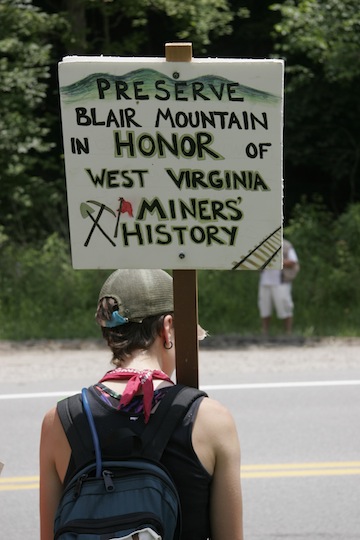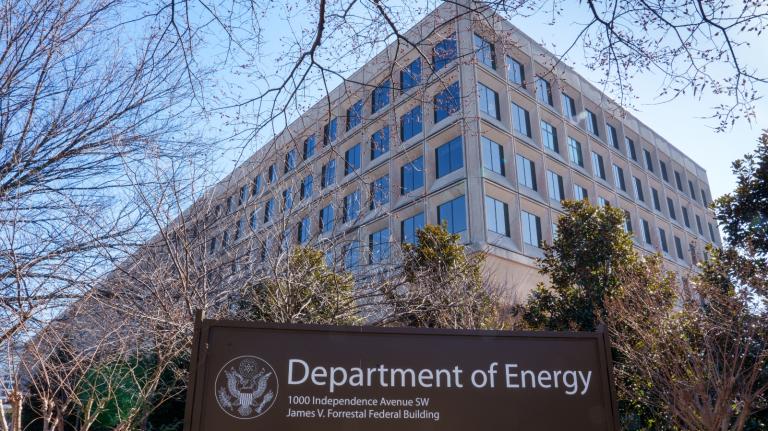 Those making the March on Blair Mountain are part of a long history of activism.Photo: Cheshire Tongkat/March on Blair MountainTim DeChristopher is a climate activist and cofounder of Peaceful Uprising. He has been beatified as a saint in the Church of Earthalujah by the Reverend Billy and convicted as a felon by the United States Government. Each of those honors were earned by disrupting a Utah BLM oil and gas auction in December 2008, in which Tim registered as Bidder 70 and outbid the oil companies. When Tim embarks on a government-sponsored writing retreat later this year, he will continue sending dispatches to Grist.
Those making the March on Blair Mountain are part of a long history of activism.Photo: Cheshire Tongkat/March on Blair MountainTim DeChristopher is a climate activist and cofounder of Peaceful Uprising. He has been beatified as a saint in the Church of Earthalujah by the Reverend Billy and convicted as a felon by the United States Government. Each of those honors were earned by disrupting a Utah BLM oil and gas auction in December 2008, in which Tim registered as Bidder 70 and outbid the oil companies. When Tim embarks on a government-sponsored writing retreat later this year, he will continue sending dispatches to Grist.
In 1921, Blair Mountain, W. Va., was the site of a major milestone in the history of the labor movement when 15,000 union miners took a stand against the coal industry. This week, Blair Mountain may end up being a new milestone in the movement to abolish mountaintop-removal coal mining and perhaps the larger climate justice movement. Hundreds of activists are recreating the miners’ historic march from Marmet to Blair Mountain to try to protect the controversial historic site from being blown up for the thin seam of coal underneath.
This week’s March on Blair Mountain may be a turning point in its own right, by helping to dispel the mythical clash between jobs and the environment that exploitative corporations have been promoting for decades. The demands of the march include sustainable job creation in Appalachia and stronger labor rights. While the decision to reach out to rank and file union miners for this week’s march may have made some anti-MTR groups uncomfortable, it can help unify the focus on the real villains who have impoverished West Virginians for 150 years: the coal industry.
As the coal industry drastically cuts its workforce in the shift towards heavily mechanized mountaintop removal, it tries to lay the blame for those job cuts on the people fighting to protect their mountains. This is nothing new. When the mechanization of the timber industry in the Northwest allowed companies to lay off workers while increasing destruction of the forests, the blame fell squarely on those who wanted to protect the spotted owl. But the history of West Virginia demonstrates that exploiting the environment and exploiting workers usually goes hand in hand. After 150 years of making coal executives rich, West Virginia still ranks almost dead last in per capita income, education, and life expectancy.
Another valuable step the March on Blair Mountain brings to the movement is to focus our perspective on social movement history. We often spend a lot of time studying science and very little time studying history. The result is a movement that knows everything about the technical problems and nothing about how change happens in this country.
When people stand on the site of the historic Battle of Blair Mountain this Saturday, June 11, it should be a moment to remember the sacrifices made 90 years earlier. Nearly 100 people died there on their way to Mingo County to try to organize a union, and nearly 1,000 more were imprisoned. In this age of one-click-activism, it’s worth remembering that power yields nothing without a struggle. The climate movement has spent years begging at the feet of a power structure that has no reason to negotiate with us. We need a reminder that our role as a social movement is, in the words of Martin Luther King, Jr., “to create such a crisis and foster such a tension that a community which has constantly refused to negotiate is forced to confront the issue.“
Perhaps the most important reason that this week’s action at Blair Mountain could be a milestone is that it’s not safe. This week’s march and demonstration are organized by the same folks who put together the Appalachia Rising event in D.C. last fall. The night before that day of action at the White House, organizer Andrew Munn told the crowd, “This is going to be a safe and positive action.” In recent months, when I’ve asked the same organizers about the March on Blair Mountain, their response usually began with a nervous and excited laugh before saying something like, “Well, nobody really knows what’s gonna happen.”
Their nervousness is not without cause. The historic march route from Marmet to Blair follows winding country roads with no shoulder and dangerous coal trucks barreling past. Saturday’s action on Blair Mountain is likely to provoke strong counterprotests organized by the coal companies. With inflammatory misinformation and a disrespectful example, the leadership of Massey Energy has encouraged a culture of sometimes violent confrontation with activists. Considering the appalling incident that resulted from activist Larry Gibson hosting a picnic on his own land, there is significant risk in occupying a high-profile proposed mountaintop-removal site.
Of course, under West Virginia’s arcane judicial system, there’s always plenty of legal uncertainty as well with any civil disobedience. It was only last year that the state passed a law, which goes into effect in 2014, requiring county judges to have a college degree. (Admittedly, after experiencing how the law works in the criminal justice system, I’m not sure if a judge’s ignorance of the law would be a bad thing.)
It’s an important step in the climate justice movement that organizers are accepting that these risks are worth taking. Much of the movement is defined by being safe. Even the direct action wing of the movement generally substitutes perceived risk for actual risk. One cannot break new ground with a certainty of safety and security.
This is absolutely not to say that recklessness should be encouraged. The organizers of the March on Blair Mountain have taken every step to minimize the risks this week. But when risks remained, they have decided not to back down. This shows not just courage, but a more complete understanding of risk.
We are often taught to consider the consequences of our actions, but rarely reminded to weigh the consequences of inaction. In this case, the consequences of inaction are the obliteration of a historic landmark, the continued poisoning of water and air, the destruction of communities, and more deaths from coal. Those marching on Blair Mountain this week know that their action is risky, but they understand that the consequences of inaction are far greater. If the rest of the movement learns from their example, we will look back on this week as a big step forward in the struggle for a healthy and just world.
If you can’t go, but want to help here are some things you can do. Please spread this stuff around.
- They’ve organized this march and action on a shoestring and are now paying for everything out of their pockets. So please donate whatever you can.
- Follow and re-tweet the March on Twitter.
- Repost messages and articles on Facebook this week. You can see updates on the event here.



